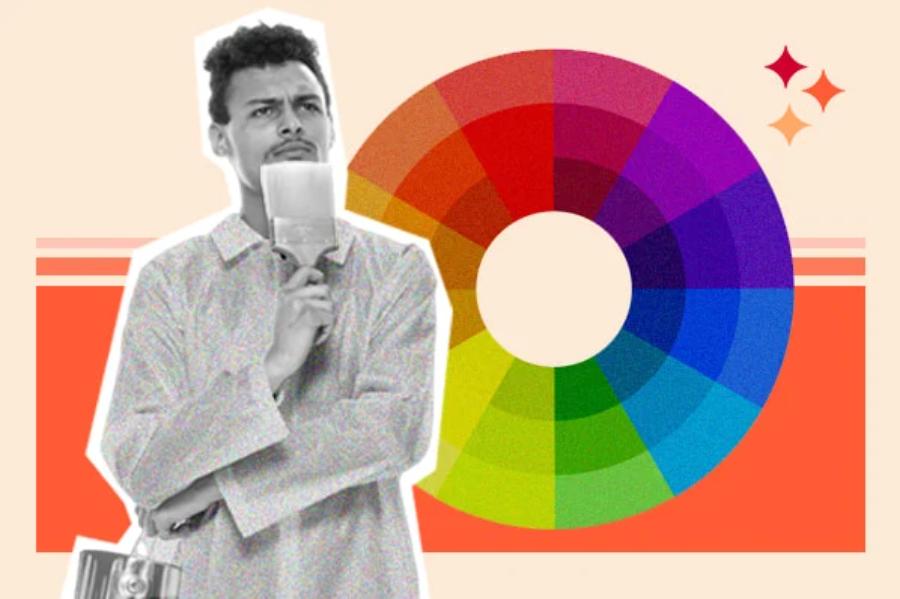Best Selling Products
Learn How to Train Your Graphic Design Mindset to Design to “Touch” Viewers’ Emotions
Nội dung
Graphic design thinking is a creative thinking process through which ideas in the head are “tangible” into specific graphic products. Through that, graphic designers will optimize them to serve the purpose of effectively conveying messages to viewers. This is a non-linear, often iterative process.

Graphic design thinking is not only the ability to create beautiful images but also the way a designer understands, feels and conveys messages through every detail in the design product. This is the core factor that helps you become different and develop sustainably in today's competitive design field. So what is graphic design thinking? How to practice this thinking effectively, especially when you are just starting out in the creative industry? Is learning software enough or do you need other skills to "upgrade" yourself to become a professional designer? In this article, SaDesign will explore with you methods to practice graphic design thinking to help you develop aesthetic thinking, creative logic and problem-solving ability through visual language.
1. What is graphic design thinking?
Graphic design thinking is a creative thinking process through which ideas in the head are “tangible” into specific graphic products. Through that, graphic designers will optimize them to serve the purpose of conveying messages to viewers effectively. This is a non-linear, often iterative process. In which designers will understand the desires of the target audience, set and test assumptions, redefine problems and create solutions through prototypes and tests.
For the graphic design industry, design thinking helps to readjust the development trend of design products. Designers put people at the center and delve into user insights to solve difficult problems in the design process.
2. What are the similarities and differences between graphic design thinking and design thinking?
.png)
Graphic design thinking and design thinking are two relatively similar concepts, but there are also some differences.
Design thinking in graphics is a creative problem-solving process, using design principles and skills to create effective solutions and meet user needs. Design thinking is often applied in graphic design fields, such as logo design, website design, application design, ...
Design thinking is a creative problem-solving approach that focuses on understanding user needs and providing appropriate solutions. Design thinking can be applied in many different fields, not just limited to graphic design.
You can distinguish these two concepts more clearly through the comparison table of design thinking (graphics) and design thinking:
Characteristic
Graphic design thinking
Design thinking
Field of application
Graphic design
Various fields
Target
Create design products that meet user needs
Solve problems creatively and effectively
Procedure
Includes the steps: problem identification and analysis, solution proposal, solution development and testing, solution implementation
Includes steps: empathize, shape, generate ideas, build prototypes, test, deploy
Tools and skills
Use design principles and skills
Use skills such as analysis, creativity, communication, collaboration
Graphic design thinking is essentially a part of design thinking. Design thinking includes the steps of graphic design thinking, but also extends to steps like empathizing, shaping, prototyping, and testing.
.png)
However, there are also some differences between the two concepts. Graphic design thinking usually focuses on creating design products that meet user needs, while design thinking focuses on solving problems creatively and effectively. (Graphic) design thinking is often applied in the field of graphic design, while design thinking can be applied in many different fields.
In general, both graphic design and design thinking are creative and effective problem-solving methods. Depending on your goals and application areas, you can choose the appropriate method.
3. The relationship between graphic design thinking and design tools
Design thinking and design tools are two important elements in the graphic design process. Design thinking provides designers with a creative and effective problem-solving method, while design tools help designers implement their ideas. Design thinking involves the following steps:
Step 1: Understand and analyze the problem to be solved. This includes identifying the goals, target audience, and other relevant factors.
Step 2: Propose solutions. After understanding the problem, the designer will start to propose solutions. These solutions need to be creative, effective and meet the needs of the user.
Step 3: Develop and Test Solutions. Once a number of solutions are available, the designer will begin developing and testing them. Developing solutions involves creating sketches, models, and prototypes. Testing solutions involves getting user feedback and making necessary changes.
Step 4: Implement the solution. Once a suitable solution has been found, the designer will proceed to implement the solution. Solution implementation involves using design skills and tools to create the final product.
.png)
Design tools are software or applications that help designers create design products. Popular design tools include:
Vector graphics software: Vector graphics software uses vectors to create images, helping designers create high-quality images that can be resized without losing quality.
Bitmap graphics software: Bitmap graphics software uses pixels to create images, helping designers create high-resolution images suitable for printing.
Web design software: Web design software helps designers create beautiful and effective websites.
App Design Software: App design software helps designers create mobile and desktop applications.
Graphic design thinking and design tools are complementary. Design thinking provides designers with a creative and effective way to solve problems, while design tools help designers implement their ideas.
For example, a graphic designer might use design thinking to identify user needs and propose a new design solution. The designer might then use a design tool to create a prototype of that design solution. The prototype might then be tested with users to get feedback. If the feedback is positive, the designer might continue to develop the solution and eventually deploy it.
4. What should designers do to practice graphic design thinking?
.png)
Learn about design thinking
There are many resources available to help designers learn about design thinking, including books, articles, online courses, and workshops. Designers can learn about design principles, creative problem-solving methods, and essential design skills.
Design Practice
The best way to practice design thinking is to practice. Graphic designers can practice design thinking by taking on design projects, entering design competitions, or simply spending time thinking about design problems.
Listen to feedback
When practicing design thinking, graphic designers should listen to feedback from others. Feedback from others can help designers improve their ideas and solutions. At the same time, you can look at problems from multiple perspectives and exploit new, creative ideas.
.png)
Some specific activities that designers can do to practice graphic design thinking:
Learn about user needs: Take the time to learn about your users' needs. You can do this by interviewing users, surveying users, or observing users.
Propose creative solutions: Think of creative solutions to design problems. Don't be afraid to come up with new ideas, even if they seem crazy.
Test solutions: Create prototypes of your solutions and test them with users. User feedback will help you improve your solutions.
Hopefully the methods shared in the article will be a useful guideline to help you develop effective and sustainable graphic design thinking. Don't forget, design is a never-ending creative journey, always keep your passion and patience to turn your ideas into the most vivid reality!












































